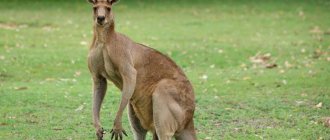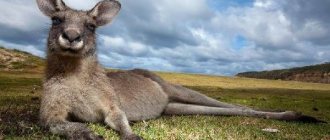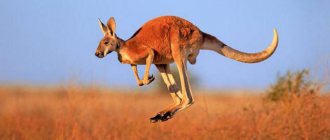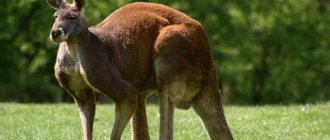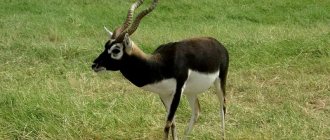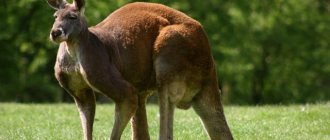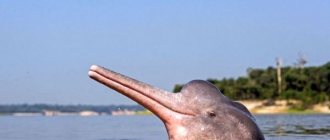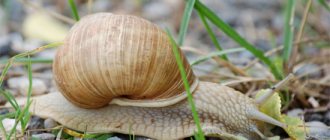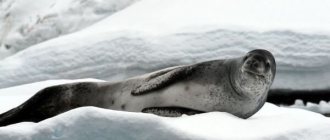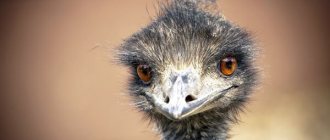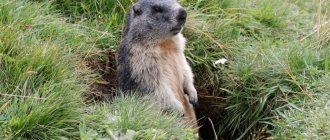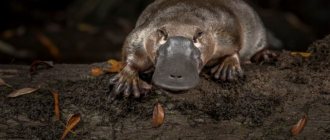Only forward!
Kangaroos are the only large animals that move by jumping. Moreover, when moving on the ground, they use both hind legs simultaneously, and when swimming, they use them in turn. The animal cannot move backwards at all. This is probably why the kangaroo is depicted on the state emblem under the motto “Australia always moves forward!”
Kangaroos cannot be called notorious fighters, but when it comes to a serious fight, the fight begins with threatening poses and ends with powerful blows from the hind legs to the stomach. At the same time, they skillfully use their powerful tail - it acts as an additional support when taking a vertical stance. The long tail and powerful hind legs allow the kangaroo to jump over two-three-meter fences, and in case of danger, reach speeds of 45 to 55 km/h, sometimes up to 65 km/h.
Kangaroo and man
It cannot be said that the kangaroo is such a dangerous animal that meeting it is fraught with mortal danger, especially since in the media this animal is positioned as friendly. Despite this, these animals, under certain conditions, can cause serious harm to human health. It should always be remembered that this is a wild animal, although the risk of attack is very low and is associated with a number of factors. Facts indicate that quite a few victims of encounters with kangaroos go to doctors throughout the year.
Kangaroos can attack a person in the following cases:
- As a result of exposure of a group of animals to various external factors.
- Constant contact with people leads to the animal losing its sense of fear.
- In case of a real threat to the animal or its offspring.
- The animal has no choice but to defend itself.
- A person interferes with the living space of a kangaroo.
- A domesticated kangaroo may be aggressive in the initial stages.
In the event of an attack on a person, the animal uses both its front and hind limbs, while using the kangaroo's tail as a support. Hitting, especially from the hind legs, is quite dangerous, and the injuries resulting from such kicks can be quite serious.
Adjustment skills
Kangaroos live in small groups and lead a predominantly crepuscular lifestyle. Being herbivores, animals prefer savannas with dense vegetation. If there is a shortage of succulent grasses, they switch to other foods (tree bark, dry and hard grass, worms and insects). Kangaroos easily survive severe droughts, as they can go without water for several days.
Kangaroos adapt very well to their surrounding reality. To communicate with each other, animals use a number of different sounds: hissing, sneezing, clicking, etc.
Red kangaroo nutrition
Having even a tiny idea about the hot shrouds of Australia, the question involuntarily arises: What do red kangaroos eat ? Red kangaroos are herbivores - they feed on leaves and bark of trees, roots, and grasses.
They scoop up food from the ground or gnaw it. Marsupials can go without water for up to two months - they extract moisture from the food they eat.
Kangaroos are able to obtain water on their own - animals dig wells, the depth of which can reach one meter. During drought, marsupials do not waste extra energy on movement and spend most of their time under the shade of trees.
In the photo there is a red kangaroo
Caring for offspring
Kangaroo cubs are born premature (weighing no more than 1 g and 2 cm long) and grow and develop in the mother’s pouch for quite a long time. Once born, the baby immediately crawls into its mother’s pouch and attaches itself to one of the four nipples. Each nipple produces its own type of milk, which depends on the age of the kangaroo. Moreover, if there are cubs of different ages, the mother can have two types of milk at the same time. The baby finally leaves the pouch only after reaching 8 months of age. Very often, at a moment of danger, a kangaroo takes the baby out of the pouch, hides it in a secluded place and leads the predator away from its offspring. Having escaped from the chase, the mother returns to the kangaroo and puts him back in the bag.
Interesting facts about red kangaroos
- According to legend, the animal was named by traveler James Cook. After he arrived on the Australian continent, the first thing he noticed were unusual animals. Cook asked local residents what they called the animal. To which one of them said “Kangaroo,” which translated from the Australian Aboriginal language means “I don’t know.” Due to ignorance of their language, Cook decided that this word meant the name of a wondrous animal.
- In order to carry babies, people have come up with special backpacks that, from a distance, resemble the belly-carrying method used by female kangaroos. Such devices are called kangaroo backpacks and are in great demand among young mothers.
You should know it
- International scientific name: Macropus rufus.
- Conservation status: Least Concern.
- Characteristics: the kangaroo differs from most animals: its hind limbs and tail are disproportionately more massive and powerful than the front ones. A small head, narrow shoulders and short front legs indicate poor upper body development. The weight of adult males reaches 80 kg, and the body length reaches 1.4 m; females are somewhat smaller.
- This is interesting: in the wild, the life expectancy of kangaroos is on average 6 years, while in captivity some individuals can live 25 years or more.
Kinds
The name “kangaroo” is sometimes taken to refer to all representatives of the family bearing the name: kangaroos. But more often this word is used to refer to the largest species of this family (they will be described below), and small kangaroos are usually called differently. In fact, the size of the members of different species varies quite significantly.
Kangaroos can measure no more than 25 cm, and can also measure up to one and a half meters or more. The largest red kangaroos are considered the largest, and the record holders for weight are members of the forest gray variety (among those mentioned, individuals weighing 100 kg are noted). These animals are Australian endemics, but they are also found on islands close to the specified mainland: in Tasmania, New Guinea and others. All the features of their appearance are clearly visible in the photo of a kangaroo .
In total, fourteen genera are known in the kangaroo family. Some of them are more widely represented, others less so, but the number of kangaroo species in the overall count is enormous. Let us describe some of them in more detail.
1. Red large kangaroo . This species belongs to the type of gigantic kangaroo; individual specimens weigh on average 85 kg, as well as an almost meter-long tail. Such animals are found either in the northern part of the continent in tropical forests or along the eastern coast in the south of the continent, preferring to inhabit the fertile areas of the said area. Jumping on their hind legs, they are able to move many tens of kilometers in an hour. Animals have a wide muzzle, and their ears are pointed and long.
Big red kangaroo
2. The eastern gray kangaroo is a very numerous species, and the population of its individuals numbers up to two million. Members of this species, which are second in size after their counterparts described above, are closest to humans in habitat, since they prefer to inhabit densely populated areas of Australia. They are found in the south and east of the continent.
Eastern gray kangaroo
3. Wallabies are small kangaroos that form a group of species. They are no more than 70 cm tall, but they are especially large, while the weight of some may not exceed 7 kg. However, despite their size, these animals jump expertly. The champions of the human race would envy them. The jump length of this type of kangaroo can be 10 meters. They are found in the steppes, swamps and mountains of both mainland Australia and nearby islands.
Female wallaby with baby in pouch
4. The kangaroo rat is more similar not even to the two animals mentioned in the name, but to rabbits. By the way, such creatures lead a completely appropriate life, living in grassy thickets, looking for and arranging homes there.
Kangaroo rat
5. Quokkas are babies from this family, weighing about 4 kg and the size of a cat, defenseless creatures that have an external resemblance to other kangaroos, but also to mice.
Quokkas
Kangaroo meat can be eaten
It is believed that kangaroos served as the main source of meat for the aborigines of Australia over the past 60 thousand years. Currently, a number of Australian scientists, citing the small amount of harmful gases emitted by kangaroos during their life, propose replacing them in the food chain with the familiar, but extremely harmful, cows and sheep. Actually, the kangaroo meat industry in modern history dates back to 1994, when active supplies of kangaroo meat came to the European market from Australia.
Notes
- Names List for MACROPODIDAE, Australian Faunal Directory. Australian Biological Resources Study (English) (Russian
) Department of the Environment and Energy (English) (Russian. Date of access: April 27, 2022. - Osphranter rufus
(English) on the website of the National Center for Biotechnology Information (NCBI). (Accessed: April 27, 2021). - Sokolov V. E.
Five-language dictionary of animal names. Mammals. Latin, Russian, English, German, French. / under the general editorship of academician. V. E. Sokolova. - M.: Rus. lang., 1984. - P. 24. - 352 p. — 10,000 copies. - Freedman CR, Rothschild D., Groves C., Newman AEM Osphranter rufus
(Diprotodontia: Macropodidae) (English) // Mammalian Species (English) (Russian: journal. - 2022. - 23 December (vol. 52, iss 998). - P. 143-164. - ISSN 1545-1410. - doi:10.1093/mspecies/seaa011. - Celik M., Cascini M., Haouchar D., van Der Burg C., Dodt W., Evans AR, Prentis P., Bunce M., Fruciano C., Phillips MJ
A molecular and morphometric assessment of the systematics of the
Macropus
complex clarifies the tempo and mode of kangaroo evolution (English) // Zoological Journal of the Linnean Society (English) (Russian: journal. - 2022. - 28 March (vol. 186, iss. 3). - P. 793-812. - ISSN 1096-3642. - doi:10.1093/zoolinnean/zlz005. - Jackson SM, Groves C.
Taxonomy of Australian Mammals (English). - CSIRO Publishing, 2015. - P. 164-165. — 529 p. - Macropus rufus
(English).
The IUCN Red List of Threatened Species
. Access date: April 27, 2022. - Around the World | Magazine | Australian hermits
- Peter Menkhorst, Frank Knight.
Field Guide to the Mammals of Australia = A Field Guide to the Mammals of Australia. - Melbourne: Oxford University Press, 2001. - 280 p. — ISBN 019550870X.
Selecting sentences from the text
It is known that chokeberry is an ornamental shrub and a valuable fruit crop. Using this information, select three statements from the list below that describe these characteristics of this plant. Write down the numbers corresponding to the selected answers.
1) Rowan ripens at the end of September. 2) Rowan is undemanding to soils. 3) Jam, jelly, marmalade, compotes, dried fruits, and juices are prepared from berries. 4) The plant is specially planted in squares and parks. 5) The plant has several stems growing from one node. 6) The plant has oblong leaves.
Answer
345
Read the text. It is known that the common mole is a soil mammal that feeds on animal food. Using this information, select three statements from the text below that describe these characteristics of this organism. Write down the numbers under which they are indicated.
(1) The body length of the animals is 18-26.5 cm, and the weight is 170-319 g. (2) Adult animals are quarrelsome with each other, attack relatives who come into their area and can bite them to death. (3) The offspring of moles are born blind, naked and helpless. At this time, the females feed him with milk. (4) The nesting chamber is located at a depth of 1.5-2 meters. (5) Along river valleys, the mole penetrates to the north to the middle taiga, and to the south to typical steppes. (6) The mole feeds on earthworms and, in smaller quantities, eats slugs, insects and their larvae.
Answer
346
It is known that Pseudomonas aeruginosa is an aerobic, microscopic, pathogenic organism. Select three statements from the text below that describe the characteristics of bacteria listed above.
(1) Pseudomonas aeruginosa is a bacterium with rounded ends, ranging in size from 0.5 to 1 microns. (2) Motile, does not have a dense capsule, does not form spores. (3) Reproduces with access to oxygen and high humidity (4) Optimal growth temperature is 37°C. (5) Often found in inflammatory processes (purulent wounds, abscesses), often causes urinary tract and intestinal infections (6) It is highly resistant to antibiotics.
Answer
135
It is known that the codling moth is an insect with complete metamorphosis and a short life. Using this information, select three statements from the text below that describe these characteristics of this organism. Write down in the numbers under which they are indicated.
(1) The codling moth is a garden pest. (2) It is a nocturnal insect and resembles a small brownish-gray butterfly. (3) The main damage to fruits is caused by codling moth caterpillars, which infect the fruit from the inside. (4) Butterflies appear when the average daily temperature is 15 degrees Celsius. (5) Its lifespan is about one and a half months and during this time the butterfly manages to make several clutches.
Answer
235
It is known that the common hippopotamus, or hippopotamus, is a large semi-aquatic herbivore mammal. Using this information, select three statements from the text below that describe these characteristics of this organism. Write down in the numbers under which they are indicated.
(1) The mass of large males reaches 4 tons, body length is 3 meters, height at the shoulders is up to 1.65 m. The nostrils, eyes and ears are slightly raised, which allows the hippopotamus to breathe, look and hear, while remaining almost completely under water. (2) A characteristic feature of the hippopotamus is its semi-aquatic lifestyle - it spends most of its time in water, coming onto land only at night for several hours to feed. (3) The skin of a hippopotamus has a gray-brown color with pinkish tints and reaches a thickness of 4 cm. (4) The total length of the digestive tract (stomach and intestines) is 60 meters, which allows the hippopotamus to absorb fiber from plants much more fully. (5) Sexual dimorphism is weakly expressed, females are 10% smaller than males. (6) The hippopotamus belongs to the order of artiodactyls, since its limbs have four fingers, each of which ends in the likeness of a hoof.
Answer
124
Read the text. It is known that the elk is a large herbivorous mammal that lives in the forest zone of Eurasia and North America. Using this information, select three statements from the list below that describe these characteristics of this organism. Write down the numbers under which they are indicated.
(1) Elk, or elk, is the largest species of deer, as it weighs up to 600 kg, height at the withers is 2.3 meters, and body length is 3 meters. (2) The color is coffee-brown in winter, darker in summer, the legs are white with wide hooves, allowing them to move through snow and swamps. (3) Lives in the taiga and mixed forests of Eurasia and North America. (4) In Western Europe it was exterminated in the Middle Ages, and in our country in the middle of the 20th century work was carried out on the domestication of moose. (5) Only males have horns and fall off in December, and new ones begin to grow in April and May. (6) In winter it feeds on shoots and bark of willow, aspen, rowan, and pine, and in summer on grasses.
Answer
136
It is known that bracken fern is a spore plant with developed conducting tissues that reproduces both asexually and sexually. Select three statements from the text below that relate to the description of the characteristics of the organism listed above.
(1) Among fern-like plants, both herbaceous and woody plants are now found. (2) The development cycle is dominated by the sporophyte - an adult, terrestrial plant. (3) The fern gametophyte is represented by a small underground growth on which gametes are formed. (4) Ferns can reach several meters in height without experiencing difficulties in the flow of water to the leaves (fronds). (5) Ferns are terrestrial plants, widespread in different layers of the forest. (6) On the underside of the frond you can see brown formations - sori containing spores.
Answer
346
Read the text. It is known that the red kangaroo belongs to the family of marsupial mammals. Using this information, select three sentences from the text below. Write down the numbers under which they are indicated.
(1) The height of a male large red kangaroo is 1.5 meters. (2) The red kangaroo can jump 13.5 meters long and 3.3 meters high. (3) The red kangaroo feeds on steppe and semi-desert grasses, cereals and other flowering plants. (4) Like other marsupials, the female kangaroo gives birth to a tiny baby weighing 1 g and 2 cm long, which grabs onto the mother’s fur and crawls into the pouch. (5) In the pouch, the cub grabs one of the nipples and attaches its lips to it for 2.5 months. He does not have the strength to suck, so the female injects milk into his mouth thanks to the contraction of special abdominal muscles. (6) Having matured, the baby kangaroo begins to make short forays out of its mother’s pouch, immediately jumping back at the slightest rustle.
Answer
456
Read the text. It is known that wheat, a herbaceous annual plant, is the leading grain crop. Using this information, select three statements from the text below that describe these characteristics of this organism. Write down the numbers under which they are indicated.
(1) Annual herbaceous plant 30-150 cm tall. (2) The temperature required for the germination of wheat seeds is +3 °C. (3) According to data for 2012, the area under crops in the world is 215.5 million hectares - this is the largest area among all agricultural crops (corn is in second place - 177.4 million hectares, rice is in third place - 163.2 million hectares) . (4) Wheat flowers are small, inconspicuous, wind-pollinated. (5) The inflorescence of wheat is a complex spike. (6) Flour obtained from wheat grains is used for baking bread, producing pasta and confectionery.
Answer
136
Read the text. It is known that the platypus is a mammal from the order of monotremes, perfectly adapted to a semi-aquatic lifestyle. Using this information, select three statements from the list below that describe these characteristics of this organism. Write down the numbers under which they are indicated.
(1) The platypus weighs 2 kg and its body length is about 40 cm. (2) Males are about a third larger than females. (3) The body of the platypus is covered with hair. The facial section of the head is elongated into a flat, leathery beak 65 mm long and 50 mm wide. The limbs are five-fingered with a swimming membrane. (4) The echidna and platypus have a cloaca into which the intestines, ureters and genital tracts open, which allows them to be classified as monotremes. (5) After mating, the female platypus digs a brood hole, which ends in a nesting chamber, and she seals the entrance to it from the inside with several earthen plugs 15-20 cm thick for protection from predators. (6) The female platypus usually lays 2 eggs. She does not have a brood pouch. She feeds the hatched cubs with milk.
Answer
346
Read the text. It is known that rose hips are a deciduous shrub that is undemanding to the soil. Using this information, select three statements from the text below that describe these characteristics of this organism. Write down the numbers under which they are indicated.
(1) The rose hip has several stems extending from a common base. All of them are covered with sharp thorns that protect the plant from being eaten by herbivores. (2) Can grow on rocky and clayey cliffs. (3) Wild rose hips are frost and drought resistant. (4) Rosehip leaves are imparipinnate, with 5-7 leaf blades, turn yellow and fall off in the fall. (5) The root system penetrates to a depth of 5 m. (6) Rose hips are the ancestor of all cultivated varieties of roses, its oil is used in medicine and perfumery, rose hips are a source of vitamin C.
Answer
124
Read the text. It is known that ancient reptiles were perfectly adapted to life on land, although they could also live in an aquatic environment, and sometimes reached enormous sizes. Using this information, select three statements from the text below that describe these characteristics of this organism. Write down the numbers under which they are indicated.
(1) The height of the animals could reach several meters, and the weight could reach several tons. (2) Eggs contained a large amount of nutrients. (3) The cubs were born blind and helpless. (4) Ichthyosaurs lived in water and could transition from laying eggs to viviparity. (5) Like modern reptiles, they were adapted to life on land. (6) They ate only plant foods.
Answer
145
It is known that the Nut Lotus plant is a heliophyte, belongs to the angiosperm division and is currently in a state of biological regression. Select three statements from the text below that relate to the description of the characteristics of Lotus Nutbearer listed above.
(1) Nut lotus is a perennial aquatic plant with a knotty rhizome. (2) After flowering, large hard seeds ripen in capsule fruits. (3) Lotus leaves are located above the surface of the water to maximize the absorption of sunlight. (4) Rhizomes, leaves and fruits contain alkaloids and flavonoids. (5) In Russia, the plant is distributed on the rivers of the Far East and on the coasts of the Azov and Caspian seas. (6) The construction of dams, drainage and pollution of water bodies have led to a narrowing of the range and a decrease in the number of this species
Answer
236
Read the text. It is known that potatoes, or tuberous nightshade, are a type of herbaceous plant, the most important food, industrial and fodder crop. Using this information, select three statements from the list below that describe these characteristics of this organism. Write down the numbers under which they are indicated.
(1) Potato is a herbaceous plant with a bare ribbed stem, odd-pinnate leaves, white, pink and purple self-pollinating flowers. (2) The homeland of potatoes is the coast of Chile and Peru. (3) Europeans did not know the potato until 1565, before the Spanish visited South America. (4) Until the end of the 17th century, potatoes were cultivated as an ornamental plant; bouquets of its flowers were used to decorate the hairstyles of queens and the buttonholes of courtiers’ camisoles. (5) Starch, molasses, and alcohol are obtained from potato tubers. (6) Potatoes are also used for fattening farm animals.
Answer
156
It is known that beavers are the largest aquatic rodents. Select three statements from the text above that relate to the description of the above characteristics of this animal. Write down the numbers under which the selected statements are indicated.
(1) The beaver's body length is about a meter, weight is 20-30 kg. (2) Beavers have powerful incisors and can gnaw tree trunks with a diameter of up to 60 cm or more. (3) Animals have special glands that secrete a fatty substance with a musky odor - “beaver stream”. (4) Beavers dive and swim well, can stay under water for up to five minutes, and move under water using their webbed hind paws. (5) Beavers are very clean animals: before going for food, they go ashore, sit on their hind legs, leaning on their tail, and carefully comb the fur on their sides, belly and head. (6) Beaver cubs are born sighted and with erupted incisors.
Answer
124
Read the text. Choose three sentences that describe the features of the social life of the most ancient people of Sinanthropus. Write down the numbers under which the selected statements are indicated.
(1) Sinanthropus is a Chinese man, the remains were found in 1927 in the village of Zhou-Gou-Dian, 50 km from Beijing. (2) They lived in herds in caves and could use fire, which they received during forest fires or during volcanic eruptions. (3) Height 150-160 cm, brain volume 850-1200 cm3. (4) The forehead is low, with a brow ridge, the teeth are large, the lower jaw without a chin protrusion. (5) They hunted buffalo, woolly rhinoceroses, mammoths, deer, and birds. (6) Speech is primitive, consisting of individual shouts.
Answer
256
It is known that tansy is a perennial herbaceous plant from the Asteraceae family, widely used in various areas. Select three statements from the text below that describe the characteristics of this plant listed above.
(1) Herbaceous plant with creeping rhizomes, straight stems, 50-100 cm high. (2) Grows in dry meadows, along river banks, on forest edges, near roads. (3) The flowers are golden-yellow, collected in baskets, the fruit is an achene. (4) The plant is poisonous, especially the inflorescences. (5) The unpleasant smell of the plant drives away insects. (6) The plant is used as an insect repellent and as an anthelmintic, choleretic, and antimicrobial medicine; the roots produce a green dye; essential oil is extracted from tansy, which is used to flavor liqueurs and canned meat.
Answer
136
It is known that the oriole is a small, beautiful, but shy and wild bird. Select three statements from the text below that describe the characteristics of this animal listed above.
(1) Lives in deciduous and mixed forests, in old light groves on tall birches, willows, alders, and oaks. (2) Body length 24-25 cm, wingspan 45 cm, weight 60-100 g. (3) The color of the plumage is bright - yellow or greenish with black or brownish wings, a dark tail and dark spots on the head. (4) The oriole destroys hairy caterpillars that are harmful to the forest in large quantities. (5) When arranging a nest, responsibilities are always clearly distributed: the male collects material, and the female puts it in place. (6) Tries to escape the gaze of humans, the bird is uncooperative and pugnacious towards its relatives, constantly quarrels with them.
Answer
236
It is known that horsetail has shoot dimorphism, performs a concentration function in the biosphere, and is a soil bioindicator. Select three statements from the text below that relate to the description of the characteristics of horsetail listed above.
(1) Horsetail is a perennial herbaceous, long-rhizome, spore-bearing plant. (2) Forms two types of above-ground shoots: spore-bearing (spring) and vegetative (summer). (3) The development cycle of horsetail is dominated by the sporophyte. (4) Horsetail accumulates silicon compounds in its stems. (5) Horsetail prefers highly acidic soils. (6) In the old days, edible tuberous thickenings of horsetail containing starch were used for food.
Answer
245
It is known that wheatgrass is a weed plant with various morphological characteristics, having one cotyledon in the seed embryo. Select three statements from the text below that describe the characteristics of wheatgrass listed above.
(1) Wheatgrass belongs to the class Monocots. (2) The nutritional value of wheatgrass is quite high, so it is well eaten by livestock. (3) The plant is very variable, the shoots are bare or pubescent, green or bluish, the stem is from 30 to 120 cm tall. (4) Creeping wheatgrass is a light-loving plant of meadow communities. (5) In fields and vegetable gardens, the plant is a competitor to cultivated species, and therefore is constantly destroyed by humans. (6) Wheatgrass was used by academician N.V. Tsitsin for crossing with wheat and obtaining high-yielding hardy hybrids.
Answer
135
It is known that the moss lichen (reindeer moss) is a complex organism with a specific structure, is a valuable food for animals, and also has bactericidal properties. Select three statements from the text below that relate to the description of the characteristics of reindeer moss listed above.
(1) The moss thallus is not differentiated into organs; green algae cells are located between the hyphae of the fungus - this is the main characteristic of such organisms. (2) Lichens have an aerobic type of metabolism. (3) Reindeer moss settles on poor soils, stones, and is found in vast areas of tundra and forest-tundra. (4) Resin moss is widely used by the indigenous peoples of the North in traditional medicine. (5) Reindeer moss constitutes a major part of the reindeer's diet, especially in winter. (6) Thanks to its extremely slow growth, reindeer moss is durable, but sensitive to anthropogenic interference in ecosystems.
Answer
145
It is known that mucor is an aerobic, unicellular organism, a representative of the kingdom Fungi. Select three statements from the text below that describe the characteristics of mucor listed above.
(1) Mucor has the characteristics of plants, animals and has its own specific characteristics; its body is represented by mycelium. (2) Its mycelium is a branched multinucleate cell. (3) Sprouting in bread, mucor makes it unfit for food. (4) The final processes of energy metabolism are carried out in mitochondria. (5) The mucor cell produces substances that kill bacteria.
Answer
124
It is known that the bacterium Vibrio cholerae is an anaerobic, unicellular, parasitic organism. Select three statements from the text below that describe the characteristics of bacteria listed above.
(1) The bacterium is formed by a curved, comma-shaped cell. (2) The bacterium lives in the small intestine of humans, causing poisoning. (3) Energy metabolism in the body of the bacterium ends with glycolysis. (4) Reproduces asexually. (5) In unfavorable living conditions it turns into a dispute. (6) The spores remain dormant for many years.
Answer
123
The red fly agaric is a representative of the separate kingdom Mushrooms. However, some signs of the fly agaric are similar to representatives of such kingdoms as Animals and Plants. In nature, this mushroom has a symbiotic relationship with trees. Select three statements from the text below that are meaningfully related to the description of the characteristics listed above.
(1) We know the red fly agaric as a large mushroom up to 10-25 cm in height. (2) It consists of a fruiting body and a mycelium. (3) The storage organic substance in cells is glycogen. (4) Free threads of the mycelium disperse widely in the soil from the roots of the tree, replacing its root hairs. (5) The fly agaric grows throughout its life. (6) This mushroom got its name because it was once used to fight flies.
Answer
345
© D.V. Pozdnyakov, 2009-2020
